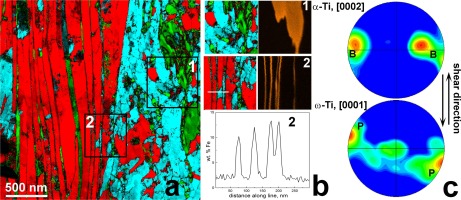当前位置:
X-MOL 学术
›
Acta Mater.
›
论文详情
Our official English website, www.x-mol.net, welcomes your feedback! (Note: you will need to create a separate account there.)
The α→ω and β→ω phase transformations in Ti–Fe alloys under high-pressure torsion
Acta Materialia ( IF 9.4 ) Pub Date : 2018-02-01 , DOI: 10.1016/j.actamat.2017.10.051 A.R. Kilmametov , Yu. Ivanisenko , A.A. Mazilkin , B.B. Straumal , A.S. Gornakova , O.B. Fabrichnaya , M.J. Kriegel , D. Rafaja , H. Hahn
Acta Materialia ( IF 9.4 ) Pub Date : 2018-02-01 , DOI: 10.1016/j.actamat.2017.10.051 A.R. Kilmametov , Yu. Ivanisenko , A.A. Mazilkin , B.B. Straumal , A.S. Gornakova , O.B. Fabrichnaya , M.J. Kriegel , D. Rafaja , H. Hahn

|
Abstract The formation of ω-phase under high-pressure torsion (HPT) has been studied in Ti–Fe alloys. Seven alloys with Fe concentration from 0 to 10 wt % have been annealed between 600 and 950 °C, quenched and HPT-treated at 7 GPa, 1 rpm, 5 and 0.1 anvil rotations (equivalent strain eeq = 156 and = 3.1, respectively). The strain after 0.1 rot. corresponds to the transient state of HPT, and that after 5 rot. corresponds to the HPT steady-state and to the dynamic equilibrium between formation and annihilation of microstructure defects. A defect-rich high-pressure ω-phase forms after HPT and persists in the samples also after the pressure release. The amount of retained ω-phase after HPT depends on the iron concentration. It increases from 40% in pure titanium, reaches maximum of 95% at 4 wt % Fe and then decreases again to 10% at 10 wt % Fe. It is because the addition of iron influences the lattice parameters in β and ω-phases in a different manner. The minimal lattice mismatch between β- and ω-phases is reached at 4 wt % Fe. A good conformity between the lattices of the β- and ω-phases enhances the probability of the martensitic (diffusionless) β→ω transformation. Based on the XRD and TEM observations, the crystallography and mechanisms of α→ω and β→ω phase transformations (which can be diffusionless as well as controlled by mass transfer) under the influence of pure shear by HPT are discussed.
中文翻译:

Ti-Fe合金在高压扭转作用下的α→ω和β→ω相变
摘要 研究了 Ti-Fe 合金在高压扭转 (HPT) 下 ω 相的形成。Fe 浓度为 0 至 10 wt% 的七种合金已在 600 至 950 °C 之间进行退火、淬火和 HPT 处理,压力为 7 GPa、1 rpm、5 和 0.1 砧旋转(分别等效应变 eeq = 156 和 = 3.1) . 0.1 腐烂后的应变。对应于 HPT 的瞬态,以及 5 rot 后的瞬态。对应于 HPT 稳态和微观结构缺陷的形成和消失之间的动态平衡。HPT 后形成了富含缺陷的高压 ω 相,并且在压力释放后也持续存在于样品中。HPT 后保留的 ω 相量取决于铁浓度。它从纯钛的 40% 增加,在 4 wt% Fe 时达到最大值 95%,然后在 10 wt% Fe 时再次下降到 10%。这是因为铁的添加以不同的方式影响 β 和 ω 相中的晶格参数。β 相和 ω 相之间的最小晶格失配在 4 wt % Fe 时达到。β 相和 ω 相的晶格之间的良好一致性提高了马氏体(无扩散)β→ω 转变的可能性。基于 XRD 和 TEM 观察,讨论了在 HPT 纯剪切影响下 α→ω 和 β→ω 相变(可以是无扩散的也可以通过传质控制)的晶体学和机制。β 相和 ω 相的晶格之间的良好一致性提高了马氏体(无扩散)β→ω 转变的可能性。基于 XRD 和 TEM 观察,讨论了在 HPT 纯剪切影响下 α→ω 和 β→ω 相变(可以是无扩散的也可以通过传质控制)的晶体学和机制。β 相和 ω 相的晶格之间的良好一致性提高了马氏体(无扩散)β→ω 转变的可能性。基于 XRD 和 TEM 观察,讨论了在 HPT 纯剪切影响下 α→ω 和 β→ω 相变(可以是无扩散的也可以通过传质控制)的晶体学和机制。
更新日期:2018-02-01
中文翻译:

Ti-Fe合金在高压扭转作用下的α→ω和β→ω相变
摘要 研究了 Ti-Fe 合金在高压扭转 (HPT) 下 ω 相的形成。Fe 浓度为 0 至 10 wt% 的七种合金已在 600 至 950 °C 之间进行退火、淬火和 HPT 处理,压力为 7 GPa、1 rpm、5 和 0.1 砧旋转(分别等效应变 eeq = 156 和 = 3.1) . 0.1 腐烂后的应变。对应于 HPT 的瞬态,以及 5 rot 后的瞬态。对应于 HPT 稳态和微观结构缺陷的形成和消失之间的动态平衡。HPT 后形成了富含缺陷的高压 ω 相,并且在压力释放后也持续存在于样品中。HPT 后保留的 ω 相量取决于铁浓度。它从纯钛的 40% 增加,在 4 wt% Fe 时达到最大值 95%,然后在 10 wt% Fe 时再次下降到 10%。这是因为铁的添加以不同的方式影响 β 和 ω 相中的晶格参数。β 相和 ω 相之间的最小晶格失配在 4 wt % Fe 时达到。β 相和 ω 相的晶格之间的良好一致性提高了马氏体(无扩散)β→ω 转变的可能性。基于 XRD 和 TEM 观察,讨论了在 HPT 纯剪切影响下 α→ω 和 β→ω 相变(可以是无扩散的也可以通过传质控制)的晶体学和机制。β 相和 ω 相的晶格之间的良好一致性提高了马氏体(无扩散)β→ω 转变的可能性。基于 XRD 和 TEM 观察,讨论了在 HPT 纯剪切影响下 α→ω 和 β→ω 相变(可以是无扩散的也可以通过传质控制)的晶体学和机制。β 相和 ω 相的晶格之间的良好一致性提高了马氏体(无扩散)β→ω 转变的可能性。基于 XRD 和 TEM 观察,讨论了在 HPT 纯剪切影响下 α→ω 和 β→ω 相变(可以是无扩散的也可以通过传质控制)的晶体学和机制。



























 京公网安备 11010802027423号
京公网安备 11010802027423号